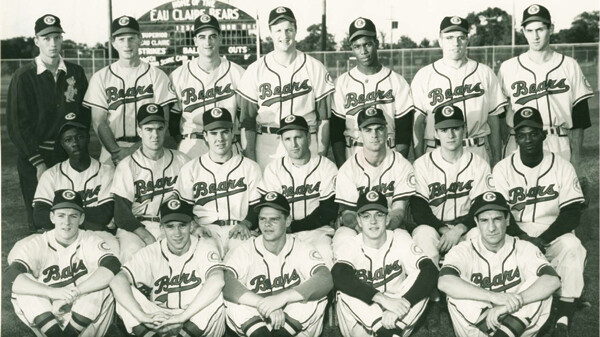Thanks for Asking | June 20, 2013
our local Jack-of-all-Facts tells you how it is
 There’s been a lot of talk lately about Jackie Robinson and that got me wondering about a local baseball question. I have the “famed” 1952 Eau Claire Bears team photo poster in my house (which I got from V1 at The Local Store!). Pictured are three African-American players. We all know how Hank Aaron turned out. But do you know anything about the other two? W. Bowers (c) and J. Covington (of)?
There’s been a lot of talk lately about Jackie Robinson and that got me wondering about a local baseball question. I have the “famed” 1952 Eau Claire Bears team photo poster in my house (which I got from V1 at The Local Store!). Pictured are three African-American players. We all know how Hank Aaron turned out. But do you know anything about the other two? W. Bowers (c) and J. Covington (of)?
Thanks for asking! I do. John Wesley (“Wes”) Covington, like Hammerin’ Hank, was young when he played for the Bears, a C-level Northern League farm team for the Milwaukee Braves. Also, like Aaron, Wes Covington was a Southerner (North Carolina in his case, Alabama for Aaron). Covington had enormous talent: a crushing left-handed hitter and a fearless outfielder. He took spring training here and played the entire season, ending 1952 with 24 home runs, 99 RBIs, and a .330 average.
After the ’52 season, Covington climbed the minor league ladder steadily, from Evansville to Jacksonville to Toledo, a triple-A farm team. The Milwaukee Braves called him up in ’57, and he helped spark the Braves to the World Series crown, driving in 65 runs in the season’s last 96 games. In the series, he drove in what became the winning run in game two.
He had an even better year in ’58, with a .330 average and 24 homers, exactly the same totals as he had with the Bears back in ’52. He even got 16 votes for the National League’s MVP award — pretty far behind Ernie Banks, Willie Mays, and Hank Aaron, but still more NL MVP votes than I’ve managed to accumulate so far.
Covington spent 11 years in the majors and played for six teams – including a major-league rarity, four teams in a single season: when he left the Braves in ’61, he went to the White Sox, then to the Kansas City A’s, then to the Phillies. He stayed with the Phillies from ’61 through ’65, and ended his career with the Cubs and the Dodgers.

Covington retired with solid stats: .279 career average with 131 home runs and 499 RBIs. He spent most of his post-baseball career as an ad manager for the Edmonton Sun newspaper and died in Edmonton a couple of years ago.
William Julius (“Julie”) Bowers was really at the other end of his career. A Staten Island native, he spent several years as a catcher for the New York Black Yankees through the late ’40s, in the twilight of the Negro National League. The Negro League had been around since 1930 (and would actually hang on in some form into the 1960s). The Black Yankees used Yankee Stadium — yep, that Yankee Stadium, “the House that Ruth built” — as their home field.
By 1950, the Black Yankees had become a “barnstorming” team, and Bowers toured the U.S. his last season or two with the team. His chances of reaching the majors from that trajectory were slim. It seems to me that, for him, the minors let him keep playing ball. Aaron thought of Bowers as part coach, part mentor, part guardian, the kind of guy, abundant in the minor leagues, who helped many young black players on the way up.
Bowers played here in ’52, ’53, and part of ’54 (in ’52, he batted .312). In ’54, he headed for Corpus Christi, Texas, and ended his minor league career at Lake Charles, La., in ’55. I’m not certain, but I think he’s still living. He would be well into his 80s.
Got a local question? Send it (205 N. Dewey St.) or email it (mail@volumeone.org) and Frank will answer it! Frank has lived in Eau Claire for most of the past 43 years. He is an editor and researcher at the Chippewa Valley Museum, which is open all year just beyond the Paul Bunyan Camp Museum in beautiful Carson Park. You should go there.






















